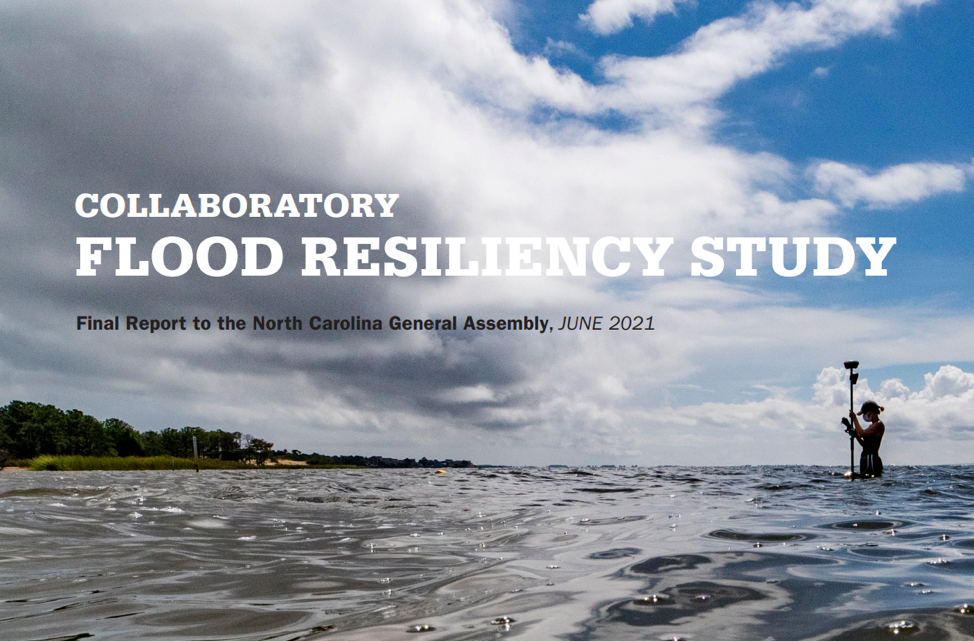Ameena Hester is a junior at UNC-Chapel Hill majoring in Public Policy with minors in Environmental Justice and Data Science. She is a National Institute Environmental Health Sciences Connect Scholar and an Environmental Policy Intern with the North Carolina Collaboratory.
More and more communities are becoming at risk from flooding than ever before. Climate change is fueling more intense hurricanes, heavier rains. Resources to protect communities from these events are not distributed equitably.
Over the last two semesters working at NC Collaboratory, I have had the opportunity to exercise my public policy interests alongside my passion for environmental justice. One such way has been through examining the environmental justice implications of floodplain buyouts, as well as the community-level impacts of floods and other natural disasters.
A Comprehensive Look at Flood Impacts in North Carolina
In June 2021, the Collaboratory submitted a Flood Resiliency Study report to the North Carolina General Assembly, which covered topics ranging from environmental financial risk to public health. The report is incredibly comprehensive, gleaning information from state and local governments to analyze the efficacy of current buyout programs, with key recommendations for future plans.
With a baseline understanding of these buyouts in the context of environmental law, I sought to understand the vulnerabilities of certain populations with respect to their historic marginalization and resource scarcity. Moreover, I wanted to learn policy approaches to equitable distribution of floodplain buyouts, or otherwise access to mitigation resources, and how best to begin implementing them.

Some recommendations included the contracting of non-governmental entities to manage floodplain buyouts, securing more state funding, and expanding the reach of these programs further into high-risk areas.
This is by no means an exhaustive list, and each recommendation certainly has its merits. During my literature review, however, social & environmental justice concerns related to such mitigation programs were raised, many of which had already been pointed out by scholars in existing research, including the authors of the Flood Resiliency Report.
Some of the concerns about inefficiencies and inequities in the buyout process include:
- Before granting funds for buyouts, FEMA requires that cost-sharing thresholds be met, which could be marginalizing for certain low-income communities.
- Social vulnerability information is largely disconnected from land acquisition processes.
- Concurrent floodplain buyouts and land development can negate any effective ends.
- Data management of existing programs is also lackluster, with buyouts and hazard-related data not yet publicly accessible.
- Cost-benefit analyses used by agencies like U.S. ACE and FEMA, lend little insight beyond what financial risks are associated with buyouts.
Working to Understand Community Concerns and Impacts
With much discussion around securing state funding, or efficiently financing buyouts, little has been suggested as to how to earn a community’s trust and approval throughout the process.
Communities empowered with the choices to control what happens to them and their communities see better results. Fostering governmental programs that offer step-by-step counsel to floodplain buyout recipients of diverse communities could prove to be helpful, along with consideration to community-level vulnerabilities and prioritization processes.
Though the prospect of privatization also comes with concerns around lack of regulation, well-resourced outside agencies could reduce some of the ongoing vulnerabilities, as well as build community trust, by providing more long-term solutions– rather than managerial emergency intervention– to communities challenged by floods and displacement.
Distributional inequities remain concerns as policymakers utilize incoming federal funds for disaster mitigation.
How will livelihoods and micro-cultures be grafted into these new places, rather than displaced, or erased? How can we prevent spatial segregation, and encourage trust?
Such are the questions that ought to be asked when considering whole-person policies.
Moving forward, policymakers should seek to fill gaps perpetuated by inequities of socioeconomic status, race, and geographic region. Each factor distinguishes one place’s needs from another.
For more information about research on this topic and research related to flood impacts in North Carolina please visit the NC Flood Resiliency Hub website: https://collaboratory.unc.edu/current-projects/flood-resiliency-hub/


